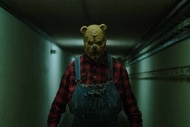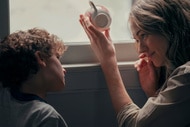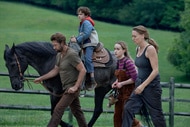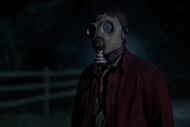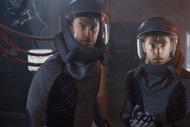Create a free profile to get unlimited access to exclusive videos, sweepstakes, and more!
Designing Westworld's post-pandemic reality required an unsettling mix of safety and security

The most daunting aspect of designing Westworld, according to production designer Howard Cummings, was the scale. Not many sci-fi shows are as widely traveled as Westworld, which broke out of its base locations of California and Utah this season to shoot in Spain and Singapore — an effort to make its futurism feel less artificial and more grounded in the real world.
In this deterministic version of the future, people have survived a pandemic, climate change has been solved, and traffic is reduced. Of course, those benefits hide other, much deeper-set issues and questions, but those hide under a veneer of security.
"You can see, especially in the earlier sequences, people are wearing masks," Cummings tells SYFY WIRE. "We had discussed what would have happened, and it was important to feel like you’d want to live here. Of course, it has a price. Everything is directed and determined, which is why Dolores blows it up."
Cummings needed to create spaces that seemed free and open above ground — with sparse travel in personalized air vehicles, or airpods — and hide the truth of the society underground, with secret labs and lairs run by A.I. strategy engines. Cummings chatted with SYFY WIRE about this season’s challenges, his inspirations, as well as the issues of working with A.I.
Let’s talk about what I imagine was your most complicated set this season: Hestia.
We had seen Serac’s lab at the unknown place where he lives, and those labs were actually based on the converted cement factory that houses the architectural workshop of Spanish architect Ricardo Bofill. Through [Danish architect] Bjarke Ingels and his connections, we were able to shoot in his offices and residence at “La Fábrica” (or “The Factory”) just outside Barcelona, which has all these postmodern-Gothic details cut into the building, like the archways. So Ricardo Bofill’s headquarters are Serac’s headquarters.
But in Episode 7, we get another one of Serac’s labs. Dolores and Caleb find a sort of defunct military base or detention center. We were trying to integrate all the looks of the different places, but also delineate them. For Hestia, I felt like we had to go white. It had to be totally antiseptic, to be visually different from what we had seen before. It felt more like laboratories that test animals, rats in cages, that spectrum of feeling. We did that early on, with a lot of glass to tie it into Delos’ labs, which are essentially black with glass.
We see Hestia’s testing labs in flashbacks first.
We shot the flashbacks in a photography studio with cool, shiny floors, but I didn’t know until later that we would have to do the rest of the facility, or that this beautiful, shiny white laboratory was secretly a defunct detention center. So I had to design this entrance that they walked through and the tunnels. It’s like an abandoned building that is actually super high tech inside, so we were looking at airplane hangars, which was part of what this detention center was. We shot that at the Ontario airport, in old air hangars out there. [VFX supervisor] Jay Worth and I had to wonder, what sort of evolution did Rehoboam go through? We had to devolve it, to figure out Solomon, Rehoboam’s predecessor. Was it more skeletal? More makeshift? We built a platform and figured out the interactive lights, with a whole rock-and-roll, metallic truss system.
Then I got a script where it said there was another underground part — another part I didn’t know about! — where all the outliers are stored in a form of cryogenic tanks on racks. And I was going, “Wow.” Caleb is told he’s part of this reeducation program, and he and Dolores go down into an underground area, theoretically below Solomon, where they find Serac’s brother, Jean Mi, in stasis, in his cryogenic capsule. We did that at the Los Angeles Convention Center, in one of their exhibition halls. I ended up building a gyroscopic holder for the tank, and the idea of that, if we’d had more time, would have been that you could see how these tanks were put in storage and also retrieved. We worked out the mechanics of the retrieval system.
The automated and flying vehicles were also your design.
To build a concept car or vehicle and have it functioning, it’s at least a 12-week process. And our basic prep for the whole show is 11 weeks! But we did it! And then we had to take some of those vehicles — like the motorcycle, the ambulance — and hold those parts of the episodes until later on, until we could get it all built.
The idea was [that] most pedestrians are going to try to travel on elevated plazas or walkways, but the vehicles, there were less of them and they were confined to certain spaces, and for the most part were fully automated. Although on our show, if you’re a bad guy, you definitely don’t want to be in an automated vehicle that could be controlled by some other A.I.! They often took off with other dual-purpose vehicles that had some sort of manual control.
We had a lot of airpods, and these were personal flying vehicles. We based those on drones. We built the cab section so the cab could be put on a crane and taken to MacArthur Park, or the support structures and landing gear could be taken to other countries. We also had a couple of airplanes that we could rework. I feel like the most bespoke version was Serac’s version, which was more personalized. I feel like he was a person who actually spent a lot of time on that plane, and wanted it to be more like a living space.
How did consulting with Ingels help on your end?
He allowed us to use a lot of his projects, which was great for building our own future map of Los Angeles. From day one of prep, Jay Worth and I had our first meeting and Jay said, “What does this new world look like? I need to know.”
To build the architecture of Los Angeles, we had some resources in Singapore, shooting in Singapore, and I had been looking at Bjarke Ingels’ work early on, even in Season 2, to see what the future might look like. And just coincidentally, I got a message from somebody, “Bjarke is a fan of Westworld. Can he come out and look at the sets?” I said, “Sure!”
So he came out, and I thought it might be for an hour, an hour-and-a-half, and he was there for six hours. I think he was fascinated by how we build stuff. He got to meet [showrunner Jonathan Nolan] at the very end, and they hit it off and became friends.
Bjarke also went scouting with us, and spent part of the day showing us some super cool parts of Barcelona that perhaps we could use for some sequences. It didn’t work out schedule-wise, but Barcelona has a long history of using pedestrian streets, and that was part of the language we were trying to use. We got into some places that not everybody gets to go into, which was exciting. And at the end of the day, he took us to a friend’s restaurant in Las Ramblas, and that was fun — just like a group of friends getting together, drinking wine, and pitching ideas of what the future looks like. [Laughs]




